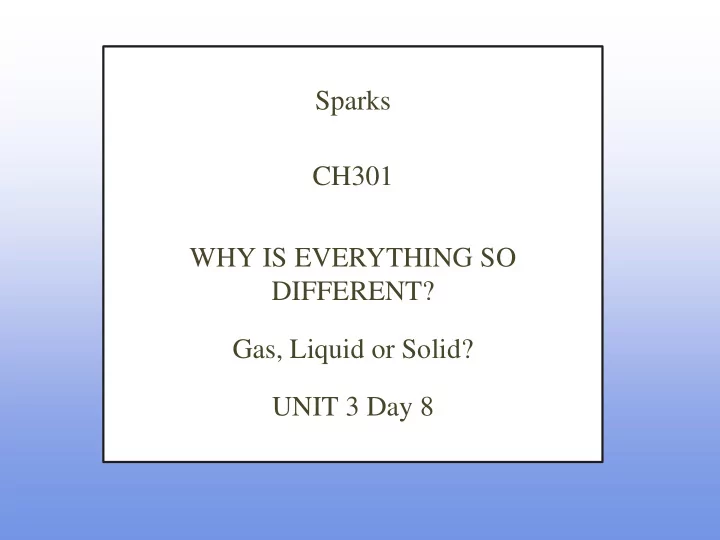

Sparks CH301 WHY IS EVERYTHING SO DIFFERENT? Gas, Liquid or Solid? UNIT 3 Day 8
What are we going to do today? Compare intermolecular forces for different molecules. Discuss the effect of these forces on properties of substances. Properties of Liquids in context of IMF
Quiz: Clicker Question INTERMOLECULAR FORCES: fact check Octane, C 8 H 18 , has a boiling point around 130 ⁰ C while water has a boiling point of 100 ⁰ C. How is this possible? A. Octane has more hydrogen bonding than water. B. The London forces in octane must be stronger than the hydrogen bonding in water. C. This cannot be possible; octane must have a lower boiling point than water since octane does not exhibit hydrogen bonding. D. Octane is more polar than water and therefore has very strong dipole-dipole forces.
Quiz: Clicker Question Which of the following has a higher boiling point? A Saturated Fatty Acid B Unsaturated Fatty Acid
Intermolecular Forces IMF Ion-Ion Dipole-Dipole Hydrogen Bonding Dispersion Forces
Intermolecular Forces: Dipole-Dipole
Intermolecular Forces: Hydrogen Bonding
Intermolecular Forces: Induced Dipole- Induced Dipole Dispersion Forces London Forces Van der Waal’s Forces Induced dipole-Induced dipole
Poll: Clicker Question For these substances: • helium • isooctane (C 8 H 18 in a straight chain) • Methane, CH 4 • calcium carbonate • glycerol (possesses three OH groups, viscous liquid) • sucrose (possesses six OH groups, solid, sugar) • Sodium chloride List in order of predicted increasing boiling point.
Poll: Clicker Question Which lists these from lowest to highest boiling point? A. He, methane, isooctane, glycerol, sucrose, NaCl, CaCO3 B. isooctane, methane, He, sucrose, glycerol, CaCO 3 , NaCl C. CaCO 3 , NaCl , sucrose, glycerol, isooctane, methane, He D. He, methane, isooctane, glycerol, sucrose, CaCO 3 , NaCl E. glycerol, sucrose, He, methane, isooctane, NaCl, CaCO 3
Complete question 5 on page 74.
Quiz: Clicker Question The BP of Sn hydride less than the BP of the Te hydride because: a) The Sn compound has a larger dipole b) The Sn compound has a smaller dipole c) The Sn compound is more polarizable (and therefore has stronger London forces) d) The Sn compound is less polarizable (and therefore has weaker London forces e) The Sn compound has more H bonding
Quiz: Clicker Question The BP of S hydride less than the BP of the Te hydride because: a) The S compound has a larger dipole b) The S compound has a smaller dipole c) The S compound is more polarizable d) The S compound is less polarizable e) The S compound has more hydrogen bonding
Quiz: Clicker Question The BP of O hydride higher than the BP of the Te hydride because: a) The O compound has a larger dipole b) The O compound has a smaller dipole c) The O compound is more polarizable d) The O compound is less polarizable e) The O compound has more hydrogen bonding
WHAT HAVE WE LEARNED TODAY? CLASSIFY INTERMOLECULAR FORCES ION-ION, DIPOLE-DIPOLE, INDUCED DIPOLE – INDUCED DIPOLE PREDICT WHAT TYPE OF IMFs EXIST FOR A PARTICULAR COMPOUND CONDENDSED PHASES EXIST BECAUSE OF IMFs – ELECTROSTATIC FORCES VARY WITH SHAPE/SIZE/COMPONENTS OF COMPOUND – PROPERTIES OF LIQUIDS DEPEND ON IMFs • VARIOUS PHASE TRANSITION TEMPERATURES • VAPOR PRESSURE
Learning Outcomes Define the three major types of intermolecular forces (IMF) discussed in class: dipole-dipole, H-bonding, and dispersion (London, van der Waals, induced dipole- induced dipole) Explain how molecular size and shape affect the magnitude of the dispersion forces Use a compound’s molecular structure to predict the types of IMFs that exist in the condensed phase Relate the IMFs to liquid properties such as boiling point, vapor pressure, viscosity and surface tension
Recommend
More recommend